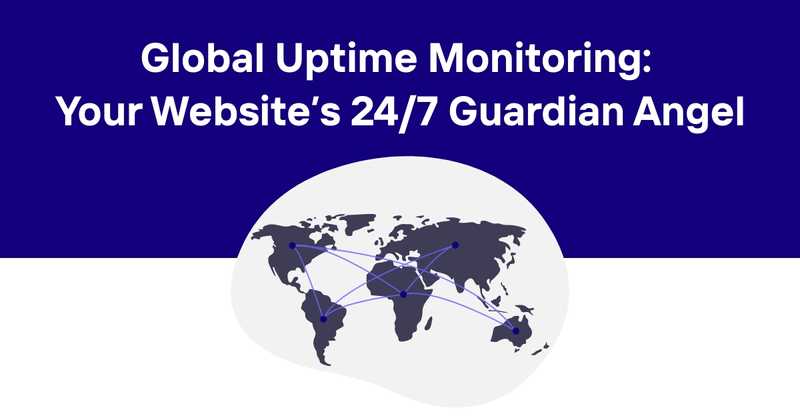Global Uptime Monitoring: Your Website's 24/7 Guardian Angel
As a software developer, I've seen my fair share of website outages and performance issues. Trust me, it's not pretty. There's nothing quite like the sinking feeling in your stomach when you realize your site is down and users can't access it. But here's the thing - you can't be glued to your computer screen 24/7 to make sure everything's running smoothly. That's where global uptime monitoring comes in. It's like having a vigilant guardian angel watching over your website around the clock.
Let's dive into the world of global uptime monitoring and explore why it's absolutely crucial for keeping your site healthy and your users happy. I'll share some hard-earned wisdom from my years in the trenches, sprinkled with a dash of humor (fair warning: my jokes are about as reliable as a website without proper monitoring).
Table of Contents
- What is Global Uptime Monitoring?
- Why Global Monitoring Matters
- Key Components of Global Uptime Monitoring
- Setting Up Effective Global Monitoring
- Interpreting Monitoring Data
- Common Pitfalls and How to Avoid Them
- The Future of Global Uptime Monitoring
- Global Uptime Monitoring Best Practices
- Tools for Global Uptime Monitoring
What is Global Uptime Monitoring?
Global uptime monitoring is like having a team of tireless robots constantly checking your website's pulse from different corners of the world. These "robots" (actually distributed monitoring servers) regularly ping your site, measure response times, and check for any signs of trouble.
But it's more than just a simple "is it up or down?" check. Good global monitoring systems track a whole host of metrics:
- Server response time
- Page load speed
- Availability across different regions
- SSL certificate status
- DNS resolution
- Content integrity
I once worked on a project where we thought our site was running smoothly, only to discover that users in Asia were experiencing painfully slow load times. If we'd had proper global monitoring in place, we could have caught and fixed the issue much sooner. Learn from my mistakes, folks!
Why Global Monitoring Matters
You might be thinking, "My website's hosted in the good ol' USA. Why do I need to monitor it from Timbuktu?" Well, let me tell you a little story.
I once built a beautiful e-commerce site for a client. Everything was perfect... until it wasn't. We started getting complaints from international customers about slow load times and timeouts. Turns out, our CDN wasn't properly configured for global distribution. We were leaving money on the table, and we didn't even know it!
Global monitoring matters because:
-
Your users are global: Even if your primary market is local, you never know where your next big customer might come from.
-
Localized issues: Some problems only show up in specific regions due to network routing, ISP issues, or geopolitical factors.
-
Performance optimization: Global data helps you fine-tune your content delivery and server infrastructure for optimal speed worldwide.
-
Competitive edge: In a world where users expect lightning-fast websites, global performance can make or break your success.
-
Early warning system: Global monitoring can alert you to emerging issues before they become widespread problems.
Key Components of Global Uptime Monitoring
Let's break down the essential elements of a robust global uptime monitoring system:
1. Distributed Monitoring Nodes
Think of these as your website's global spy network. Monitoring nodes are servers strategically placed around the world to check your site from different locations. The more nodes you have, the more comprehensive your coverage.
2. Customizable Check Frequency
You get to decide how often these nodes ping your site. It could be every minute, every five minutes, or at custom intervals. Just remember, more frequent checks mean more data... and potentially higher costs.
3. Multiple Protocol Support
A good monitoring system should be able to check various protocols:
- HTTP/HTTPS for web pages
- TCP for port availability
- DNS for proper domain resolution
- SMTP/POP3/IMAP for email services
- Custom API endpoints
4. Intelligent Alerting
Because nobody wants to be woken up at 3 AM for a false alarm. Advanced monitoring systems use AI and machine learning to reduce noise and only alert you to genuine issues.
5. Historical Data and Trending
It's not just about real-time monitoring. Historical data helps you spot trends, plan for capacity, and make informed decisions about your infrastructure.
6. Integration Capabilities
Your monitoring system should play nice with your other tools. Whether it's sending alerts to Slack, creating tickets in Jira, or triggering automated remediation scripts.
Setting Up Effective Global Monitoring
Alright, you're convinced that global uptime monitoring is the bee's knees. But how do you actually set it up? Here's a step-by-step guide:
-
Define Your Monitoring Goals: What exactly do you want to track? Basic uptime? Page load speed? Specific API endpoints? Be clear about your objectives.
-
Choose Your Monitoring Locations: Select monitoring nodes that align with your user base. If you have a lot of traffic from Europe and Asia, make sure you have nodes in those regions.
-
Set Up Check Types: Configure the types of checks you want to run. This might include:
- Simple ping tests
- Full page load checks
- Transaction monitoring (e.g., simulating a user login)
- API health checks
-
Configure Alerting Thresholds: Decide what constitutes an alert-worthy event. Is it when your site is down for 1 minute? 5 minutes? When response time exceeds a certain threshold?
-
Establish Escalation Procedures: Who gets notified when there's an issue? How do alerts get escalated if the problem isn't resolved quickly?
-
Integrate with Your Workflow: Connect your monitoring system to your team's communication tools (Slack, email, SMS) and ticketing systems.
-
Set Up Dashboards: Create easy-to-read dashboards that give you at-a-glance insights into your website's global health.
-
Test Your Setup: Don't wait for a real outage to find out if your monitoring is working. Simulate issues to ensure your alerts and escalation procedures are functioning correctly.
Remember, setting up global monitoring isn't a "set it and forget it" kind of deal. You'll need to regularly review and adjust your configuration as your website and user base evolve.
Interpreting Monitoring Data
So, you've got your global uptime monitoring all set up, and data is pouring in. Great! But what does it all mean? Let's break it down:
Uptime Percentage
This is the big one - the percentage of time your site was available during a given period. Here's a handy table to put those numbers in perspective:
| Uptime % | Downtime per year |
|---|---|
| 99% | 3.65 days |
| 99.9% | 8.76 hours |
| 99.99% | 52.56 minutes |
| 99.999% | 5.26 minutes |
Anything less than 99.9% uptime should raise some eyebrows. And if you're running a mission-critical application, you should be aiming for that coveted "five nines" (99.999%) uptime.
Response Time
This measures how long it takes for your server to respond to a request. As a general rule:
- < 100ms: Excellent
- 100-300ms: Good
- 300-1000ms: Needs improvement
- is > 1000ms: Houston, we have a problem
But remember, response times can vary dramatically based on the user's location relative to your servers. That's why global monitoring is so crucial - it helps you identify and address regional performance issues.
Error Rates
Keep a close eye on the percentage of requests that result in errors (like 404s, 500s, etc.). A sudden spike in error rates could indicate a serious problem, even if your site is technically "up."
Geographic Performance Variations
Look for patterns in performance across different regions. If users in Australia are consistently experiencing slower load times, it might be time to invest in a CDN or additional server capacity in that region.
Correlation with External Factors
Sometimes, performance issues aren't your fault. (I know, shocking, right?) Look for correlations between your monitoring data and external factors like:
- Major sporting events or holidays
- Internet service provider outages
- DDoS attacks
- Solar flares (okay, maybe not that last one... but you never know!)
Common Pitfalls and How to Avoid Them
In my years of wrangling websites, I've seen plenty of monitoring mishaps. Here are some common pitfalls and how to steer clear of them:
-
Alert Fatigue: Don't set your alerting thresholds too low, or you'll end up ignoring them altogether. Start conservative and adjust based on real-world data.
-
Monitoring the Wrong Things: Make sure you're tracking metrics that actually matter to your users and business. Don't get bogged down in vanity metrics.
-
Insufficient Coverage: If you're only monitoring from one or two locations, you're missing the big picture. Cast a wide net with your monitoring nodes.
-
Ignoring Trends: Don't just react to alerts. Regularly review your historical data to spot trends and address issues before they become critical.
-
Lack of Context: A spike in response time might not mean much on its own. But if it coincides with a new feature release, that's valuable context for troubleshooting.
-
Overlooking Third-Party Dependencies: Your site might be up, but if a critical third-party service is down, your users are still affected. Monitor your entire ecosystem.
-
Not Testing Your Monitoring: Regularly verify that your monitoring system itself is working correctly. You don't want to discover a configuration error during an actual outage.
The Future of Global Uptime Monitoring
As someone who's been in the trenches of web development for years, I've seen monitoring tools evolve from simple "ping" checks to sophisticated, AI-driven systems. So, what's next on the horizon? Here are my predictions (with a small disclaimer that my crystal ball is about as reliable as a Windows 95 machine):
-
AI-Powered Predictive Analysis: Imagine a monitoring system that doesn't just tell you when your site is down, but predicts potential issues before they happen. Machine learning algorithms could analyze patterns in your performance data to forecast problems and suggest preemptive actions.
-
Enhanced User-Centric Monitoring: Future monitoring tools might simulate real user behavior more accurately, providing insights not just on technical performance, but on the actual user experience across different devices and network conditions.
-
Integrated Security Monitoring: As cyber threats evolve, expect to see tighter integration between uptime monitoring and security monitoring. Your uptime tool might also keep an eye out for potential DDoS attacks or unusual traffic patterns.
-
IoT and Edge Computing Monitoring: With the rise of IoT devices and edge computing, monitoring systems will need to adapt to track performance across a much more distributed and diverse network of endpoints.
-
Blockchain-Based Monitoring: Blockchain technology could provide a decentralized, tamper-proof way to record and verify uptime data, especially crucial for applications where uptime metrics are tied to SLAs or financial transactions.
-
Augmented Reality Visualizations: Why stare at boring charts when you could don a VR headset and walk through a 3D visualization of your global network performance? (Okay, this one might be a bit far-fetched, but a dev can dream, right?)
Global Uptime Monitoring Best Practices
After years of late-night debugging sessions and frantic calls from clients, I've learned a thing or two about keeping websites up and running smoothly. Here are some best practices I swear by:
-
Monitor from Multiple Perspectives: Don't just check if your server is responding. Monitor from the end-user perspective, including full page loads, JavaScript execution, and third-party resource availability.
-
Set Realistic SLAs: Your uptime goals should be ambitious but achievable. 100% uptime is a myth (trust me, I've chased that white whale). Aim for 99.9% or higher, depending on your business needs.
-
Implement Redundancy: Your monitoring system should have its own redundancy. Use multiple providers or tools to ensure you're not flying blind if one system fails.
-
Regularly Review and Update: Your monitoring needs will change as your application evolves. Schedule regular reviews of your monitoring setup to ensure it's still meeting your needs.
-
Educate Your Team: Make sure everyone understands the monitoring system, what the alerts mean, and how to respond. An alert is useless if no one knows what to do with it.
-
Monitor the Full Stack: Don't just focus on your application layer. Monitor your entire stack, including databases, caching layers, and any microservices.
-
Use Synthetic Transactions: Set up monitors that simulate critical user journeys, like logging in or making a purchase. This can catch issues that simple uptime checks might miss.
-
Correlate Metrics: Look at the relationships between different metrics. A spike in CPU usage coupled with increased response times could indicate a very different problem than increased response times alone.
-
Plan for Scale: As your user base grows, so will the demands on your monitoring system. Choose a solution that can scale with your needs.
-
Document Everything: Keep detailed records of your monitoring setup, alert thresholds, and incident response procedures. Future you (or your successor) will thank you.
Tools for Global Uptime Monitoring
Now, I could bore you with a long list of monitoring tools, but instead, let me share a personal anecdote. I once worked for a company that insisted on building their own monitoring solution from scratch. "We're developers!" they said. "How hard could it be?" Well, let me tell you, about three months and countless sleepless nights later, we all wished we had just used an existing tool.
There are plenty of great monitoring solutions out there, each with its own strengths. Some popular options include:
- Pingdom
- Uptime Robot
- New Relic
- Datadog
- Site24x7
But if you're looking for a tool that combines uptime monitoring, SSL certificate monitoring, and both public and private status pages, I'd be remiss not to mention Odown.io. It's designed specifically with developers in mind, offering a comprehensive suite of monitoring tools to keep your websites and APIs running smoothly.
With Odown.io, you get:
- Global uptime monitoring from multiple locations
- Detailed performance metrics and historical data
- SSL certificate monitoring to prevent unexpected expirations
- Customizable public and private status pages to keep your team and users informed
- API monitoring for tracking the health of your backend services
Plus, it integrates seamlessly with popular development tools and workflows, making it easy to incorporate into your existing processes.
Remember, the best monitoring tool is the one that fits your specific needs and integrates well with your workflow. Don't be afraid to try out a few options before settling on the right one for you.
In conclusion, global uptime monitoring isn't just a nice-to-have - it's a critical component of maintaining a reliable, high-performance website in today's global digital landscape. By implementing robust monitoring practices and leveraging tools like Odown.io, you can catch issues before they impact your users, optimize performance across different regions, and ultimately deliver a better experience for your global audience.
So, go forth and monitor! Your future self (and your users) will thank you. And remember, in the world of web development, what you don't know CAN hurt you - but with proper monitoring, you'll always be one step ahead of potential problems.



